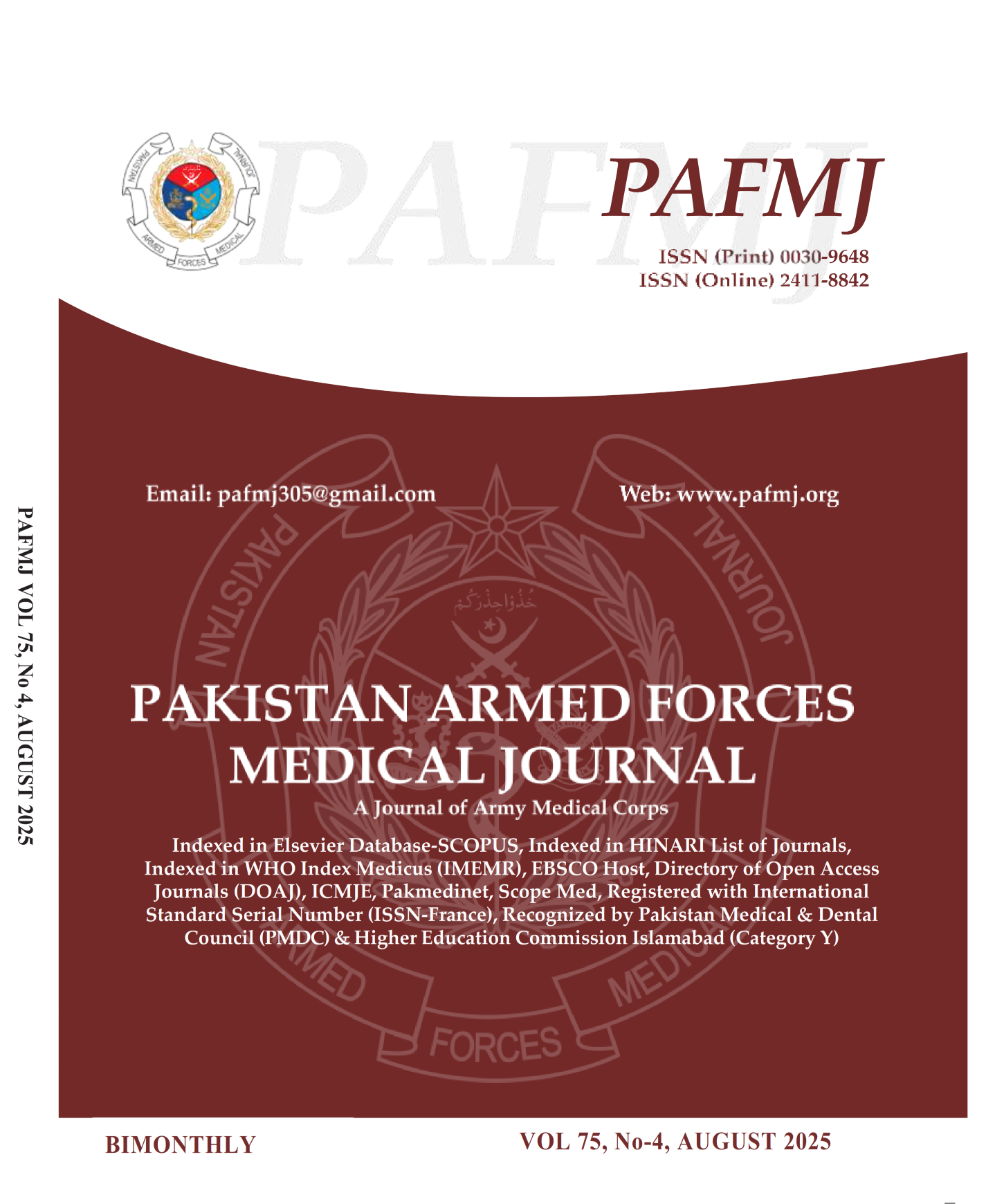omparison of CSMC (Cedar Sinai Medical Center) QGS/QPS (Quantitative Gated SPECT/Quantitative Perfusion SPECT) and INVIA-4 Dimension Myocardial SPECT Softwares for Quantitative Analysis of Left Ventricular Perfusion and Function in Gated Myocardial SPECT Scintigraphy
DOI:
https://doi.org/10.51253/pafmj.v75i4.10764Keywords:
Gated myocardial SPECT scintigraphy, Left ventricular parameters, QGS, QPS, 4DMAbstract
Objective: To compare left ventricular parameters using Quantitative Perfusion SPECT / Quantitative Gated SPECT (QPS / QGS) and 4 Dimension-Myocardial SPECT (4-DM) softwares.
Study Designs: Analytical Cross Sectional study
Place and Duration of Study: Nuclear Medical Centre, Armed Forces Institute of Pathology Rawalpindi, Pakistan from Jun 2022 to Jun 2023.
Methodology: One hundred and thirty seven patients with suspicion of coronary artery disease underwent myocardial perfusion scan during study duration. The patients underwent stress and rest gated SPECT imaging using a single day protocol. All the images were processed using QGS / QPS and 4-DM softwares separately and left ventricular parameters including Summed Stress Score (SSS), Summed Rest Score (SRS), Summed Difference Score (SDS), End Diastolic Volume (EDV), End Systolic Volume (ESV) and Ejection Fraction (EF) were calculated. Mean values and relationship between both softwares were calculated.
Results: Out of 137 patients, 80(58.4%) were men and 57(41.6%) were women with mean age of 56.29±15.17 years. The mean SSS, SRS, SDS, EDV, ESV and EF by QGS was 9.83±8.08, 6.24±6.01, 2.54±2.18, 93.94±42.73 ml, 48.04±38.16 ml and 55.94±18.06 %. While by 4-DM was 9.07±7.41, 6.72±6.39, 2.84±2.51, 97.64±43.46 ml, 45.02±40.29 ml, 61.59±18.36 % respectively. All the left ventricular parameters including SSS, SRS, SDS, EDV, ESV and EF as measured by both softwares showed substantial variation with a p-value of <0.001 suggesting significance statistical difference.
Conclusions: The left ventricular parameters assessed by both softwares differ significantly, so both softwares should not be used interchangeably for a single patient.
Downloads
References
1. Khan MA, Hashim MJ, Mustafa H, Baniyas MY, Al Suwaidi SK, AlKatheeri R, et al. Global epidemiology of ischemic heart disease: results from the global burden of disease study. Cureus 2020; 12(7). http://doi.org/10.7759/cureus.9349
2. Timmis A, Vardas P, Townsend N, Torbica A, Katus H, De Smedt D, et al. European Society of Cardiology: cardiovascular disease statistics 2021. Eur Heart J 2022; 43(8): 716-799.
http://doi.org/10.1093/ehjqcco/qcac014
3. Safiri S, Karamzad N, Singh K, Carson-Chahhoud K, Adams C, Nejadghaderi SA, et al. Burden of ischemic heart disease and its attributable risk factors in 204 countries and territories, 1990–2019. Eur J Prev Cardiol 2022; 29(2): 420-431.
https://doi.org/10.1093/eurjpc/zwab213
4. Secinaro A, Ait-Ali L, Curione D, Clemente A, Gaeta A, Giovagnoni A, et al. Recommendations for cardiovascular magnetic resonance and computed tomography in congenital heart disease: a consensus paper from the CMR/CCT working group of the Italian Society of Pediatric Cardiology (SICP) and the Italian College of Cardiac Radiology endorsed by the Italian Society of Medical and Interventional Radiology (SIRM) Part I. La Radiologia Medica 2022; 127(7): 788-802.
http://doi.org/10.1007/s11547-022-01490-9
5. Printezi MI, Yousif LI, Kamphuis JA, van Laake LW, Cramer MJ, Hobbelink MG, et al. LVEF by Multigated Acquisition Scan Compared to Other Imaging Modalities in Cardio-Oncology: a Systematic Review. Current Heart Failure Reports 2022; 19(3): 136-145. https://doi.org/10.1007/s11897-022-00544-3
6. Reeves RA, Halpern EJ, Rao VM. Cardiac imaging trends from 2010 to 2019 in the Medicare population. Radiol Cardiothorac Imaging 2021; 3(5): e210156.
https://doi.org/10.1148/ryct.2021210156
7. Garcia EV, Slomka P, Moody JB, Germano G, Ficaro EP. Quantitative clinical nuclear cardiology, Part 1: Established applications. J Nuc Cardiol 2020; 27: 189-201.
http://doi.org/10.1007/s12350-019-01906-6
8. Papandrianos NI, Feleki A, Moustakidis S, Papageorgiou EI, Apostolopoulos ID, Apostolopoulos DJ. An explainable classification method of SPECT myocardial perfusion images in nuclear cardiology using deep learning and grad-CAM. Applied Sciences 2022; 12(15) 7592.
http://doi.org/10.3390/app12157592
9. Wang T, Lei Y, Tang H, He Z, Castillo R, Wang C, et al. A learning-based automatic segmentation and quantification method on left ventricle in gated myocardial perfusion SPECT imaging: A feasibility study. J Nucl Cardiol 2020; 27: 976-987.
https://doi.org/10.1007/s12350-019-01594-2
10. Al-Shammari AF, Afzal U. Comparison of totally automated and manual processing for calculation of left ventricular volumes and ejection fraction using gated myocardial perfusion SPECT. Cardiometry 2022; 1(22): 136-142
http://doi.org/10.18137/cardiometry.2022.22.136142
11. Nichols K, Santana CA, Folks R, Krawczynska E, Cooke CD, Faber TL, et al. Comparison between ECTb and QGS for assessment of left ventricular function from gated myocardial perfusion SPECT. J Nucl Cardiol 2002; 9(3): 285-293.
http://doi.org/10.1067/mnc.2002.121449
12. Knollmann D, Knebel I, Koch KC, Gebhard M, Krohn T, Buell U, et al. Comparison of SSS and SRS calculated from normal databases provided by QPS and 4D-MSPECT manufacturers and from identical institutional normals. Eur J Nucl Med Mol Imaging 2008; 35: 311-318.
http://doi.org/10.1007/s00259-007-0600-5
13. Lavender FM, Meades RT, Al-Nahhas A, Nijran KS. Factors affecting the measurement of left ventricular ejection fraction in myocardial perfusion imaging. Nucl Med Commun 2009; 30(5): 350-355 http://doi.org/10.1097/MNM.0b013e328329d9ab
14. Nilüfer bicakci. Normal gated miyokardiyal perfüzyon spect’ e sahip kadin hastalarda sol ventrikül ejeksiyon fraksiyonu ve volüm değerleri: 4D-MSPECT ve siemens ICON®-QGS ile karşilaştirma. J Contemp Med 2018; 8(3): 239-244
http://doi.org/10.16899/gopctd.435461
15. Lum DP, Coel MN. Comparison of automatic quantification software for the measurement of ventricular volume and ejection fraction in gated myocardial perfusion SPECT. Nucl Med Commun 2003; 24(3): 259-266.
Downloads
Published
Issue
Section
License
Copyright (c) 2025 Zeeshan Sikandar, Fida Hussain, Muhammad Adil, Muhammad Atif, Asad Malik, Hafiza Shameela

This work is licensed under a Creative Commons Attribution-NonCommercial 4.0 International License.















